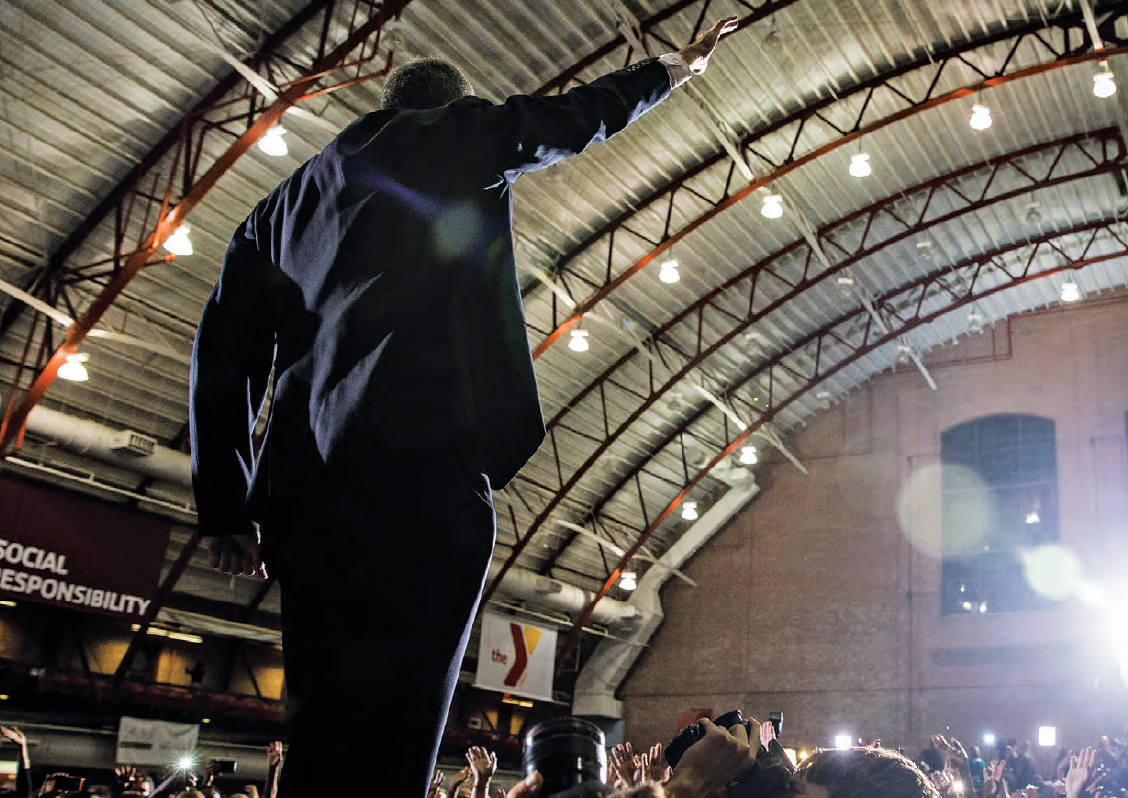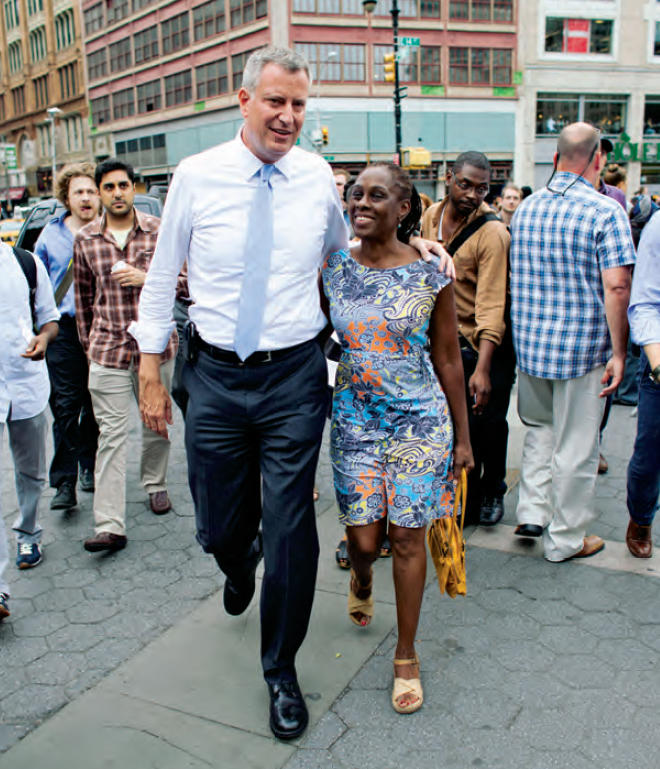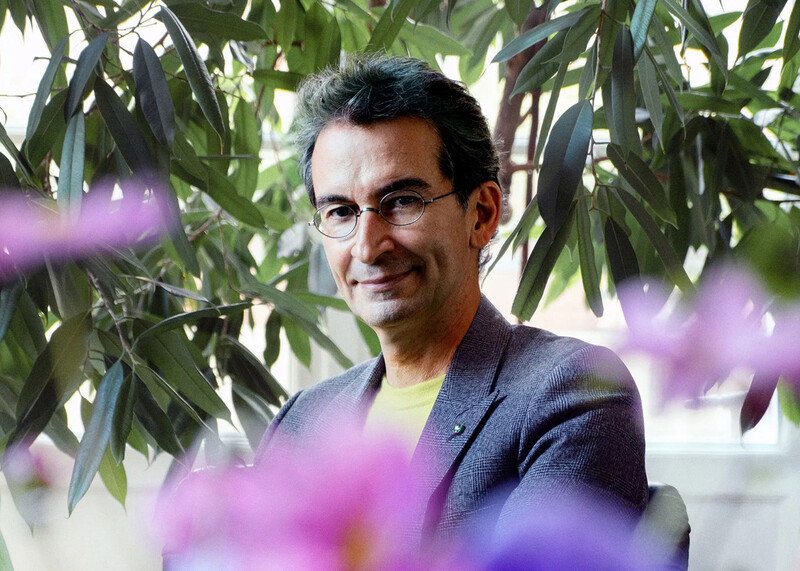
On February 6, 1912, Seth Low 1870CC, the former president of Columbia and former mayor of New York, presided over a 350-guest dinner at Delmonico’s restaurant on Fifth Avenue. The occasion was the centenary of Charles Dickens’s birth. This pairing was consistent for Low. In 1901, as a mayoral candidate, he had campaigned with Mark Twain, who was often called “the American Dickens.” It was Dickens who moved Low to offer birthday benedictions at Delmonico’s, and Dickens who, a hundred years hence, would inspire another Columbia-educated New York mayor — one who, like Low, had roots in Brooklyn — supplying him with a campaign slogan that spanned more than just the centuries.
It was the age of wisdom, it was the age of foolishness, and certainly it was the age of metaphors. “Let’s be honest about where we are today,” Bill de Blasio ’87SIPA said to the knot of reporters on hand for his campaign kickoff in Brooklyn last January 27. “This is a place that in too many ways has become a tale of two cities.” Thus a catch phrase, if not Victorian literature itself, entered the political mix of 2013. Though the metaphor for income inequality wasn’t exactly congruent with the London–Paris reference of Dickens’s title, the repetition of “a tale of two cities” did evoke Dickensian social imagery, and de Blasio carried the theme straight through to election night.
His victory speech took place in Brooklyn’s Park Slope Armory, a nineteenth-century National Guard building whose long, vaulted drill hall, hangar-huge, now serves as the basketball-courts-and-track area of the local YMCA. In a city accustomed to having its candidates gather with supporters under the chandeliers of hotel ballrooms, this was an unusual setting: the metal bleachers and goldenrod floor emitted a distinctly informal, outer-borough flavor of rec leagues, Lions Clubs, and canned-food drives.
But, then, Bill de Blasio, the public advocate for the City of New York, was an unusual candidate. Unknown to most New Yorkers as recently as the summer, de Blasio and his tightly run ship gained current on July 10 after his arrest during a protest over the closure of Brooklyn’s Long Island College Hospital; caught a late-July zephyr stirred by the sinking of Anthony Weiner; and cruised full-sail ahead in August with the unfurling of a TV ad featuring his Afroed, Brooklyn-jacket-wearing fifteen-year-old son, Dante — establishing, in thirty seconds, the candidate’s bona fides on stop-and-frisk, public schools, boroughs not named Manhattan, race relations (his wife, Chirlane McCray, is African-American), and family values. A growing crew of supporters saw him breeze through the Democratic primary to become, astonishingly, the presumptive next mayor. And with each successive stop — the Children’s Aid Society in East Harlem to tout universal pre-K, with Bill (always “Bill,” even to these preschoolers) ducking into a classroom and regaling a dozen four-year-olds with a reading of the adoption-themed My Family Is Forever by Nancy Carlson (“Families are formed in different ways,” he began, “so they don’t always look alike”); the rally on behalf of $7.35-an-hour fast-food workers in front of a Financial District Burger King (“This is an insupportable situation where everyday hard-working people can’t make ends meet”); the raucous, red-clad New York State Nurses Association powwow by City Hall (“I am committed to that outlandish notion you deserve a fair contract”) — with each appearance, they saw the candidate become, at no cost to his rolled-up-shirtsleeves affability, increasingly mayoral. They felt the peculiar crescendo of the inevitable, measured in the swelling crowds, the press and cameras, the men in dark suits and white earpieces, and the trails of excited passersby who pursued the candidate down sidewalks and across plazas to the waiting black SUV.
Of the dozen alumni of King’s College and Columbia who became mayor of New York, three in particular had a far-reaching impact on the city.
DeWitt Clinton 1786CC, who was the first graduate of Columbia College, became mayor in 1803. Clinton established the city’s public-school system, appointed the planners of its grid of streets and avenues, and later, as governor, fought for the construction of the Erie Canal. Then there was Abram Hewitt 1842CC, benefactor of Cooper Union and dedicator of the Brooklyn Bridge, who became mayor in 1886 and earned the title “father of New York underground rapid transit” for having pushed through a bill in the state legislature outlining plans for a subway system. And Seth Low? He spearheaded the consolidation of the twin cities of New York and Brooklyn and the territories of Queens, the Bronx, and Staten Island into a single municipality in 1897, and became mayor of that metropolis five years later.
Now comes de Blasio, whose own Erie Canal–sized task may be to convince the state legislature and Governor Andrew Cuomo to raise the city income-tax rate from 3.88 percent to 4.41 percent for five years on New Yorkers making half a million dollars a year or more, in order to fund universal pre-K and after-school programs for all middle-school students. Might the tale of two cities come down to New York and Albany?
At 9:00 p.m., people file into the Park Slope Armory. The Other New York, you could call it, nothing hoity-toity, just swatches of the “gorgeous mosaic” celebrated a quarter century ago by David Dinkins, New York’s last Democratic mayor and now a professor of public affairs at SIPA. A youthful core of enthusiastic, middleclass college graduates makes this reminiscent of a 2008 Obama rally, though with more Hasidim. The citizens fill the space in front of a platform that holds risers and a lectern posted with a campaign-red sign reading PROGRESS.
There are no balloons. No nail biting. The results are foregone, and the mood is one of post-climactic contentment. At 9:45 p.m., on a giant screen, de Blasio’s opponent, MTA chief Joe Lhota, who warned in a TV ad that a de Blasio victory would plunge the city into a montage of 1970s graffiti and overturned squad cars, concedes defeat. Two thousand partisans in the Park Slope Armory cheer. The music picks up, signaling hipness and optimism: Florence and the Machine’s “Dog Days Are Over,” Fun’s “We Are Young,” and U2’s “Beautiful Day.”
As people wait for the mayor-elect, some reflect on what motivated their support for de Blasio.
“Definitely stop-and-frisk,” says Lennox, sixty-four, a transit worker from the Bronx. “That’s number one. Two: housing. Don’t turn hospitals into luxury apartments. Three: homelessness has reached record numbers. It’s covered up, but it’s very bad.” Herbert Block ’87CC, the assistant executive vice president of the American Jewish Joint Distribution Committee, says, “I knew Bill at SIPA, and he’s just the same smart, compassionate guy he was in his student days. He’ll be a mayor who is interested in the whole city.” “This is a unique opportunity to push Dems to the left,” says Aisha Keller, twenty-six, an organizer at the American Federation of Teachers. “Dems are bullied in New York and feel they have to move to the center. We need someone to push the Dems to the left.” “I don’t trust politicians,” says Sofia, who is every inch a journalist from France. “If he does 10 percent of what he promises, then it would be nice.” Democratic congressman Jerrold Nadler ’69CC says, “It’s going to be a major change — a progressive mayor. I’m looking for a change in stop-and-frisk and in fiscal priorities. He wants to fund universal pre-K, and I think he’s got a good shot of getting it through Albany.”
“De Blasio has run a brilliant campaign,” said Ester Fuchs, a professor of public affairs and political science at SIPA, a week before the election. “He is the only candidate who has a vision and a very clear message, which is about income inequality and affordability. His messages are clean and simple, and they’ve resonated with the public.”
While even a detractor might have expected that de Blasio, the erstwhile political operative who managed Hillary Clinton’s successful Senate run in 2000, should himself have a well-ordered campaign, Fuchs believes that “smart Bill de Blasio, who is not just substantively smart but politically and strategically smart, understands that campaigns and governing are very different activities.” Nor does Fuchs, who served as a special adviser on governance and strategic planning for Mayor Michael Bloomberg, worry that the candidate who ran as the anti-Bloomberg will undo any positive legacies. “I don’t expect that at all,” she said. “Bill understands what’s working, and in the general-election campaign, you saw him inching toward a more centrist position. On stop-and-frisk, he’s saying, ‘I’m not eliminating it, I just want to fix it.’ When he talks about charter schools, he now says that only the charters that have a lot of money should pay for co-location, not that every charter should pay rent in a public-school building. What he would say is that he further refined his position. Which I think is correct: that’s what he did. But he’s refining it, in my view, in the right direction for when he has to govern.”
The de Blasio–McCray quartet, so recognizable that a supporter’s T-shirt portrays the family in silhouette crossing Abbey Road (capturing the distinctive variations in height and hairstyles), enters at 10:03 p.m., waving and smiling. McCray, in a matador-red dress, steps to the lectern, looking overjoyed. Someone yells, “First Lady!” Big cheers. It’s McCray’s night, too.
She says, “When I first met Bill I could tell he was smart. And I like smart.” That was in 1991, when they were both aides to Mayor Dinkins, and McCray was identifying as a lesbian. They discovered they were soul-mates and decided to see where it went. Far, it turned out. “Bill is strong enough to fight for what’s right,” McCray tells the crowd, and then she introduces the next mayor of New York.
De Blasio, with his wife, son, and rose-crowned college-sophomore daughter, Chiara, standing with him, thanks his troops, points out that the real work is just beginning, speaks a little Spanish, declares his pride in his children, gives a grazie a tutti to his ancestral hometowns of Grassano and Sant’Agata de’ Goti, mentions taking a phone call earlier from Joe Lhota, vows to work to earn the trust of those who didn’t vote for him, and arrives, right on schedule, at his central theme.
“I’ve spoken often about a tale of two cities,” he says. “That inequality — that feeling of a few doing very well, while so many slip further behind — that is the defining challenge of our time.” It is a speech, and a setting, with geography at its heart. “The best and the brightest are born in every neighborhood,” de Blasio says. “We all have a shared responsibility and a shared stake in making sure their destiny is defined by how hard they work and how big they dream, and not by their ZIP Code.”
It was the biggest crowd ever convened in the two cities.
On May 24, 1883, tens of thousands of people lined the streets and packed the rooftops on both shores to watch the procession of dignitaries and military regiments make the historic crossing. The river was clogged with bunting-draped vessels, whose sails passed whispering under the miraculous span strung high between the two granite towers by a necklace of cables. On the other side, the Brooklyn side, in the railway depot, Mayor Seth Low stood before an assembly that included President Chester A. Arthur, Governor Grover Cleveland, New York mayor Franklin Edson, and industrialist Abram Hewitt. “At either end of the bridge lies a great city — cities full of vigorous life,”
Low said. “The activities and the energies of each flow over into the other.” The speaker, known as “the boy mayor,” was thirty-three years old. “Fourteen years ago,” he said, “a city of four hundred thousand people on this side of the river heard of a projected suspension bridge with incredulity. The span was so long, the height so great, and the enterprise likely to be so costly, that few thought of it as something begun in earnest.” Low was mayor of Brooklyn then. And for one November night in 2013, inside the castle-like outer walls of the Park Slope Armory, with his own great enterprise at hand, so was Bill de Blasio.
Nonetheless, the new mayor, like Low before him, was in a consolidating state of mind.
“Make no mistake,” de Blasio told New Yorkers on election night. “The people of this city have chosen a progressive path, and tonight we set forth on it, together, as one city.”



